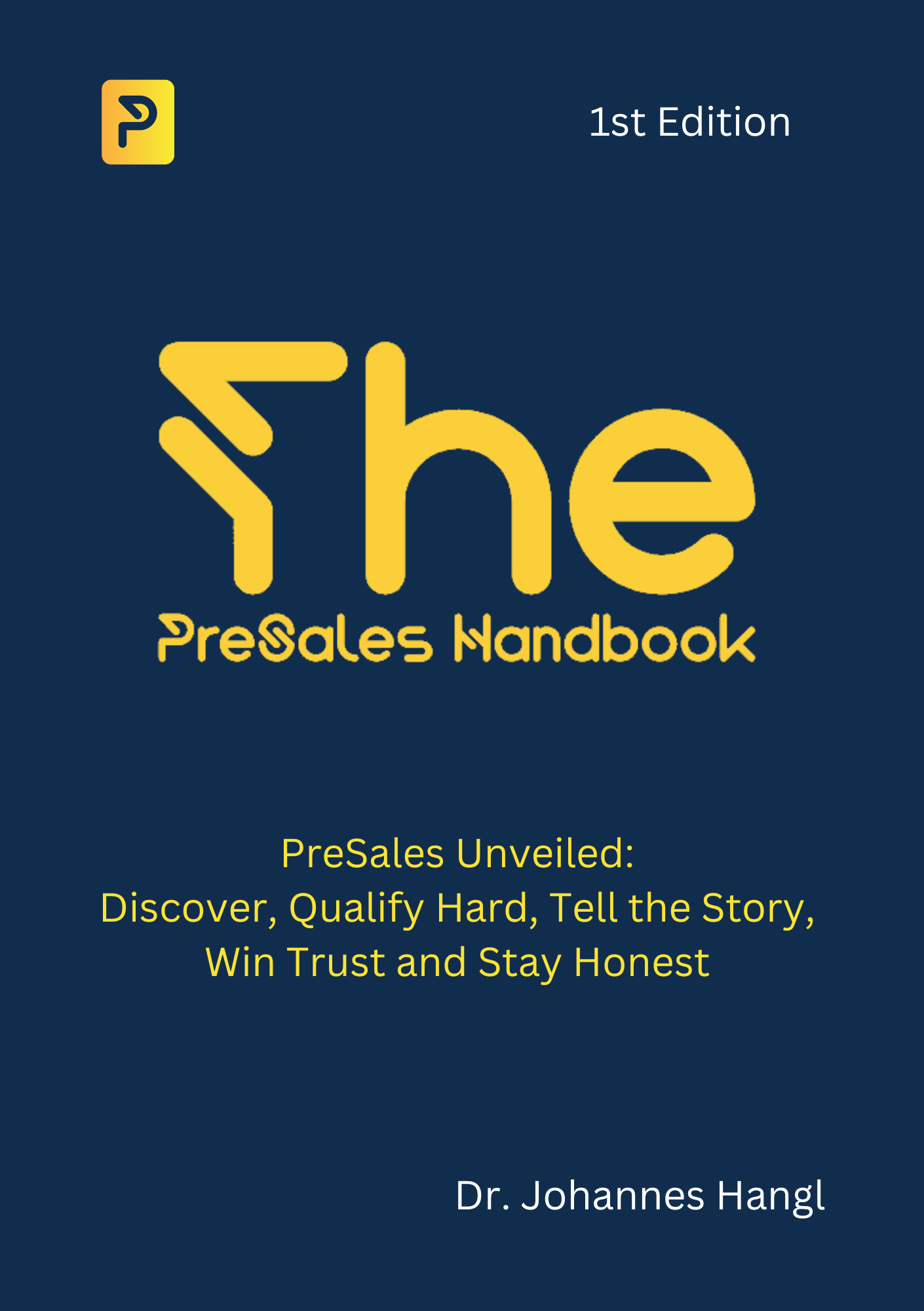Closing
The concept of „closing“ transcends the mere act of securing a signature on a contract. It encapsulates the entire journey from the initial engagement to the final agreement, underscoring a pivotal shift in the role of PreSales professionals. These individuals stand at the juncture of technical expertise and client support, playing a critical role that extends beyond just facilitating a deal closure.
The Essence of Closing: A Fusion of Art and Science
Closing a deal is a delicate balance between the methodical precision of science and the nuanced finesse of art. From a scientific perspective, it involves a thorough understanding of the product, its integration capabilities, and the overall value proposition. This domain is where PreSales professionals excel, leveraging their deep product knowledge and technical insight to clarify complexities and solidify client confidence.
Conversely, the artistic side of closing is deeply entrenched in empathy, relationship-building, and the ability to connect on a human level. It’s about engaging in meaningful dialogue, identifying unarticulated concerns, and narrating a compelling story that paints the product not just as a tool, but as a catalyst for transformation and success.
The Pitfalls of Regression
A key principle in the closing phase is to avoid reverting to earlier stages such as the demo or „Teach-Prove“ phases. Such regression can inadvertently signal uncertainty, undermining client confidence and muddling the focus from the strategic value of the solution back to its basic functionalities. This not only breaks the sales momentum but also risks elongating the sales cycle, potentially diverting the client’s attention to competitors.
Navigating Towards a Seamless Closure
Closing should naturally emerge as the culmination of a collaborative narrative crafted by both the PreSales professional and the prospect. Here are several strategies to ensure a smooth transition:
Consolidate and Reiterate Value: Summarize the journey, highlighting how the solution aligns with and addresses the client’s specific needs, thereby reinforcing the transformative impact promised.
Anticipate and Address Hesitations: Be prepared for any last-minute doubts, demonstrating readiness and a comprehensive understanding of the client’s concerns.
Foster a Partnership Ethos: Shift from a transactional to a partnership perspective, emphasizing ongoing support and a shared vision for success.
Encourage Feedback: Post-closure feedback is invaluable, offering insights that can refine future strategies, improve client engagement, and influence product evolution.
Framework for Handling Objections
The objection-handling process in PreSales is likened to a seasoned diplomat navigating through complex negotiations. It requires a balance of listening, maintaining composure, understanding underlying concerns, and striving for resolutions. This approach transforms objections from hurdles into opportunities for enhancement, deeper client understanding, and solution customization.
Objections can be either latent, hidden initially and surfacing later, or expressed, where concerns are directly voiced by the prospect. Addressing these requires a systematic approach akin to a well-rehearsed dance, starting with true and active listening to grasp the full extent of the objection. Empathy follows, acknowledging the objection’s validity without necessarily agreeing with it, which helps in maintaining trust and rapport.
Delving deeper into objections through probing questions uncovers their roots, allowing for a direct, transparent, and expert addressing of the concern. Post-addressing, a check-in with the prospect ensures clarity and the resolution of doubts. Technical objections often relate to integration, scalability, or security features, while non-technical objections might revolve around pricing, commitments to other vendors, or implementation concerns.
Persistent objections, despite efforts to address them, might require proposing a pilot or trial, engaging subject matter experts for more in-depth explanations, or scheduling follow-up meetings for further discussion.
Cultivating an objection-handling mindset involves staying informed on product developments, market trends, competitor landscapes, and practicing active listening and regular objection-handling exercises with colleagues. This mindset ensures PreSales professionals are equipped to transform objections into stepping stones towards securing and solidifying client relationships.
Key Framework for Handling Objections:
Listen Actively: Understand the objection fully before formulating a response.
Empathize: Acknowledge the concern to maintain trust.
Probe Further: Ask questions to uncover the root of the objection.
Address Directly: Provide honest, clear, and informative responses.
Confirm Resolution: Ensure the prospect’s concerns have been adequately addressed.
Role of PreSales
The role of PreSales in the sales process, particularly in closing deals, has evolved significantly due to the complexity of modern products, especially in the SaaS sector. This shift underscores the necessity to redefine traditional sales roles and acknowledges the critical role PreSales professionals play in the closing stage.
Closing is fundamentally about securing a mutual commitment between the client and seller, ensuring the product offered is the optimal solution for the client’s unique challenges and needs. It’s the final step in a series of interactions, discussions, and demonstrations aimed at providing assurance to the client. This is where PreSales professionals come into the spotlight, their product knowledge and technical expertise proving invaluable.
Technical validation is central to the closing process. PreSales professionals demystify technical complexities, translating product functionalities into tangible benefits, thus dispelling any lingering doubts a prospect might have. This process not only involves addressing how the product works but also its value, potential, and relevance to the prospect’s specific context.
Moreover, modern sales, particularly for high-value products or services, often involve decisions made by a committee rather than an individual. This adds complexity to the closing process, making the role of PreSales professionals even more crucial. They become the chief reassurers, addressing the specific concerns and questions of various stakeholders, thus facilitating a consensus and paving the way for a successful close.
The involvement of PreSales in closing goes beyond securing a sale; it lays the groundwork for long-term relationships. By ensuring product adoption is based on genuine understanding and alignment, PreSales professionals set the stage for ongoing engagement, future upselling opportunities, and sustained client loyalty.
Setting the Stage for Closing
Closing the deal in PreSales is likened to the climactic finale of a symphony, where every prior engagement — meetings, demos, challenges, and discussions — plays a crucial role in the ultimate success of the deal. It’s essential to craft a cohesive story from these elements, leading naturally to a confident ‘yes’ from the client.
Just as the final scene of a film is impactful due to the buildup of the storyline, character development, and emotional investment, the closing process in PreSales hinges on effectively weaving together all preceding interactions with the prospect. This involves revisiting past discussions to uncover and address pain points, aspirations, and concerns, thus creating a compelling narrative that resonates personally with the prospect.
For example, if scalability was a concern raised during a demo, the closing should not merely restate the product’s scalability features. Instead, it should contextualize these features within the prospect’s future growth plans, directly linking the product’s capabilities to the prospect’s ambitions. This approach ensures the solution is seen as an integral part of the prospect’s path forward, addressing concerns by embedding the product in their envisioned future.
Clarity is paramount in the closing stage, where the value proposition should be articulated with precision, covering all aspects including product features, customisations, integration, support, pricing, and terms. This clarity is vital not only for securing the sale but also for laying the foundation for a lasting, mutually beneficial relationship built on understanding and trust.
Closing, therefore, is the harmonious conclusion to a journey filled with detailed interactions. By revisiting past interactions and ensuring clarity in the proposition, PreSales professionals can guide the closing process from being a mere transactional act to a meaningful culmination of a partnership journey. This holistic approach transforms closing into an opportunity for setting the stage for future collaboration and shared success.
Key Closing Techniques
Understanding the psychology behind various closing techniques can significantly enhance their effectiveness, turning them into art forms in their own right.
One such technique, the Assumptive Close, is characterized by a shift in conversation from „if“ to „when“ and „how“, subtly suggesting the sale is already a foregone conclusion. This method banks on the positive interactions and signals throughout the sales process, using them to gently nudge the prospect towards envisioning the solution as part of their future.
The Summary Close, on the other hand, mirrors the climax of a gripping narrative, intertwining the client’s challenges and the proposed solutions to create a compelling story of transformation. It emphasizes the journey undertaken together and the significant impact of the solution on the client’s challenges, reinforcing the value proposition and the promise of a brighter destination.
Drawing parallels with a therapist’s approach, the Question Close invites prospects to express any hesitations or concerns openly, fostering an environment of transparency and trust. This technique allows for addressing any lingering doubts directly, ensuring a solid foundation for the partnership.
Lastly, the Incentive Close injects a sense of urgency into the decision-making process, reminiscent of the limited-time offers found in bustling marketplaces. By introducing time-sensitive incentives, this method encourages prospects to make swift decisions, capitalizing on the opportunity before it lapses.
Relationship Beyond the Close
The transition from closing a sale to nurturing an ongoing relationship is essential in the business world, marking the beginning of a deeper commitment. Successful PreSales professionals understand that a sale is not the end goal but the start of a sustained, evolving partnership. This process involves ensuring a smooth handover from PreSales to Post-Sales, similar to a relay race where the baton is passed without disrupting the momentum. The aim is to move from the potential and promises showcased during the sales process to the tangible realities of implementation, all while ensuring the client feels supported and valued.
As the client moves into the realm of practical application, PreSales professionals play a crucial role in bridging past discussions with current needs, acting as a valuable resource for any technical queries that arise. This continuity ensures that clients remain confident and supported as they integrate the product or solution into their operations.
Beyond the initial transition, the real work of building a relationship begins. Engagement and communication are key. Soliciting regular feedback from clients helps monitor their satisfaction and address any issues promptly. These interactions are not merely procedural but are essential touchpoints that demonstrate ongoing commitment and a desire to see the client succeed. Positive feedback is used to reinforce success, while constructive criticism offers valuable insights for improvement.




